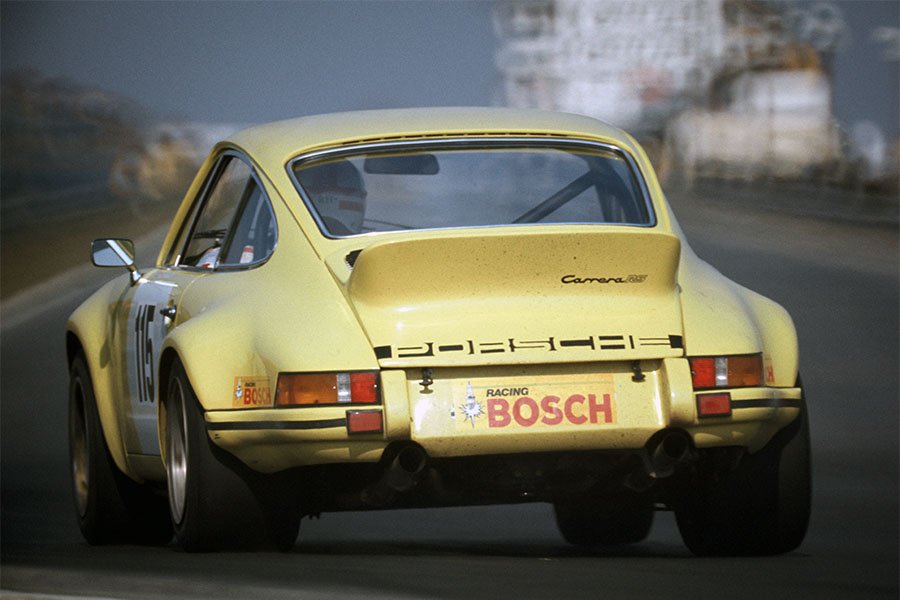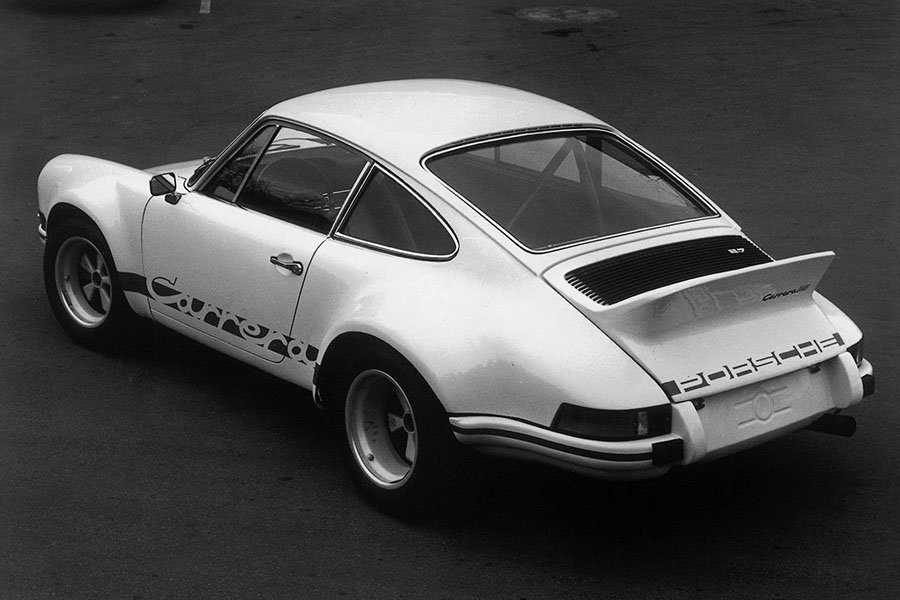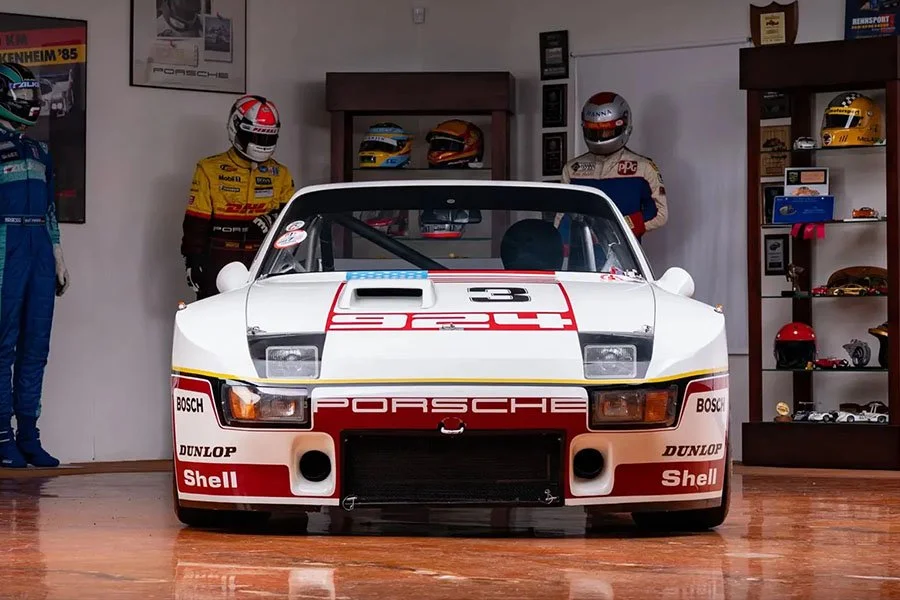Guide: Porsche 911 2.8 / 3.0 Carrera RSR / 73 - a Historical & Technical Appraisal
/BACKGROUND
Since the late 1950s, Porsche had primarily focused its factory motor sport programmes on Sports and Prototype racing cars. During this period there had been the odd works foray with enhanced 911s, but for the most part the company’s attention had been on purpose-built as opposed to production-based machinery.
That all changed when Ernst Fuhrmann was appointed Porsche Chairman in 1972.
Fuhrmann quickly decided the company should focus more on the 911. As a result, the 1973 season would mark the swansong for the legendary 917 and begin a new era for the 911.
In order to have the most potent 911 racer at its disposal for 1973, Porsche created the 2.7-litre Carrera RS to serve as the base car for a further uprated RSR competition variant.
To homologate the RSR into the premier Group 4 Grand Touring category, a minium of 500 Carrera RS road cars would have to be built within a twelve month timeframe.
Porsche launched the Carrera RS at the Paris Motor Show in October 1972. Following production of the first 500 cars, Group 4 homologation was approved on March 1st 1973.
That season, the resultant 911 Carrera RSR would be campaigned by the factory-supported Martini International, Penske and Brumos teams who normally ran tricked out R-numbered machines often equipped with prototype features. These experimental works cars are covered separately.
Additionally, an off-the-shelf Group 4 911 RSR was placed on sale to anyone with enough cash to buy one (at a price 60% igher than a 2.7 Carrera RS). Nevertheless, uptake was impressive and 49 of these 2.8 / 3.0 Carrera RSR / 73 Customer cars were built during a brief seven month production run starting January 1973.
Buyers could race their RSR in a variety of competitions to include the World Sportscar Championship, the IMSA GT Championship, Trans-Am, the European GT Championship and the Deutsche Rennsport Meisterschaft (DRM). They would go up against a formidable line up of existing Group 4 cars to include the Ferrari 365 GTB/4C, De Tomaso Pantera Gr.4 and Chevrolet Corvette.
CHASSIS
Each RSR was built on a unitary steel bodyshell without any rustproofing or sound deadening. Like the RS, a lightweight floorpan was fitted and the suspension mounts were reinforced.
Additional upgrades on the RSR included solid drivetrain mountings and a front strut brace.
Like every 911 from this era, suspension was via torsion bars and telescopic shocks. The front end used a compact MacPherson strut arrangement with a single lower wishbone. At the rear, semi-trailing arms were installed.
Compared to the RS, the RSR was enhanced with any array of new parts to include stiffer Bilstein dampers and thicker adjustable anti-roll bars. Hard plastic bushings were used for many of the suspension mounts. A needle-type bearing was adopted for the front axle control arm and rear axle strut connection.
To alter the rear trailing arm’s axis of rotation and keep the contact patch of the tyres as flat as possible, the rear axle link was shortened and the pivot point on the cross tube was moved backwards.
The brake system was also suitably uprated, most notably with cross drilled and ventilated 300mm discs and finned four-piston calipers imported from the 917. Brake balance was fully adjustable.
To reduce the dynamic radial variation during dive under braking, the steering knuckle of the front axle was moved upwards on the damper tube.
To achieve an improved adhesion between the hub and rim when braking, Porsche fitted reinforced hubs with a larger diameter, five-screwed driving pins and a central nut with a larger friction surface.
Dunlop shod 15-inch diameter Fuchs alloy wheels measured 9 and 11-inches across (up from 6 and 7-inches respectively). Also present were wheel hub spacers and larger wheel bearings.
Customers could choose from one of five different fuel cells for their RSR. The 62-litre steel tank or 85-litre plastic tank both retained the standard fuel filler cap on the left-hand front fender. Plastic tanks of 100 or 110-litres, or the expensive FIA spec. 120-litre tank, all came with a quick fuel filler cap mounted in a front lid cutaway.
The two battery boxes housed in the front fenders could be removed to improve brake cooling. When this option was taken up, a single battery was mounted in the concealed smuggler’s box.
ENGINE / TRANSMISSION
In the engine bay was a Type 911/72 engine developed from the Type 911/83 motor fitted to the RS base car.
As usual, the new engine was a dry-sumped, air-cooled, all-alloy Flat 6 with single overhead camshaft valve gear.
Thanks to a 2mm bore increase (92mm instead of 90mm), displacement was increased from 2687cc to 2806cc (a gain of 119cc). Stroke length was kept at 70.4mm.
The 2mm bore increase was made possible thanks to cylinder heads that were further apart and Nikasil cylinder linings with aluminium rather than magnesium castings. New forged pistons enabled the compression ratio to be hiked from 8.5:1 to 10.3:1. Connecting rods were specially balanced.
In addition, the RSR motor featured a huge array of hot parts to include four bearing racing camshafts with uprated housings, throttle bodies with intake funnels, rocker arms without adjusting screws, Marelli (later Bosch) twin plug ignition, bigger inlet and exhaust valves, ported cylinder heads, ST valve timing, new Bosch mechanical fuel-injection with an uprated space cam to increase fuel flow, a smaller engine fan and a dual pipe straight through competition exhaust.
The original magnesium alloy crankcase was replaced by a heavier but stronger item fashioned from Silumin alloy.
The crankshaft was imported from the RS albeit lightened, crack-tested and polished and with a new crankshaft damper.
Peak output was 308bhp at 8000rpm and 217lb-ft at 6200rpm.
For comparison, the 2.7 RS pumped out 210bhp at 6300rpm and 188lb-ft at 5100rpm.
Porsche secretly began running a three-litre engine in their R-numbered RSRs in mid April of 1973.
2940cc engines with around 315bhp subsequently began appearing in Customer RSRs from early July.
Later, the proper three-litre Type 911/74 motor also came on stream. It was bored out by an additional 3mm (to 95mm) which gave a displacement of 2993cc and a power output of circa 330bhp.
The existing five-speed 915 gearbox was retained, albeit now with its own oil cooler and an additional pump for pressure lubrication. There was also a lightweight flywheel and a steel disc clutch spring instead of a rubber torsion damper. An uprated limited-slip differential with 80% locking factor was fitted as standard.
BODYWORK
Like the 2.7 RS, the RSR came with body panels that were considerably lighter than on series production 911s.
Thinner steel was for the front and rear wings, the front lid and the roof. The engine cover was fibreglass and featured an integrated Ducktail spoiler. Below was a single piece fibreglass bumper.
A fibreglass single piece bumper was also fitted up front and came with a large rectangular intake to feed an oil cooler. A chin spoiler was soon added as well.
All four wheelarches were more dramatically flared than on the RS.
Rubber retaining straps were added to the front lid.
Like the M471 Sport-optioned RS, thin Glaverbel glass was installed. The rear quarter windows did not open.
‘Carrera’ decals colour matched to the wheel centres were normally adhered down each flank and a matching ‘Porsche’ script was added across the engine lid.
INTERIOR
The RSR’s cockpit was based on that of the M491-optioned RS Sport.
Fabric Recaro buckets were fitted – the driver got a proper racing seat with a six-point harness while the simple passenger-side item was imported from the RS Sport. A fire extinguisher and roll cage were fitted as standard.
Thin black felt was glued in place instead of proper carpet and there was a simple black fabric headliner.
Door trim panels were the same simplified type fitted to the RS Sport and the windows were manually operated.
There were no rear seats and, to save even more weight, even the clock and passenger-side sun vistor were left off.
Instrumentation comprised a 10,000rpm tachometer mounted centrally flanked to the right by a 300kph speedometer, both of which were unique to the RSR. Off to the left were combined read outs for oil pressure / oil temperature and fuel / oil level.
WEIGHT / PERFORMANCE
Porsche managed to trim away 60kg from the 2.7-litre RS H in its transition to RSR trim which put it right on the 900kg Group 4 weight limit. The RSR was also 75kg lighter than an M471 Sport-optioned 2.7-litre RS (975kg) and 175kg less than the M472 Touring version (1075kg).
Depending on gear ratios, 0-62mph could be dispatched in as little as 4.4 seconds. Similarly, top speed could run to 175mph. For comparison, the 2.7 RS had a 153mph top speed and 0-62mph times of 5.4 / 5.7 seconds for the Sport / Touring.
PRODUCTION
Porsche built 49 examples of the RSR Customer / 73 between January and August of 1973.
All 49 were left-hand drive.
The RSR Customer / 73 was replaced by 1974 version based on the revised G Body version.
COMPETITION HISTORY
All but a handful of these cars were pressed into competition duty and the RSR quickly established itself as the dominant Group 4 machine of its era despite a smaller engine than most of its rivals.
Astonishingly, even they were up against Group 5 Prototypes from the likes of Ferrari, Matra and Mirage , two of the R-numbered works RSRs won World Sportscar Championship races outright in 1973: Brumos took victory at the Daytona 24 Hours and Martini International won the Targa Florio.
With eight wins against Ferrari’s two, Porsche easily secured the FIA World Sportscar Championship Cup for GT Cars with 140 points to 40 for the Italians. Chevrolet placed third on 38.
The two American rounds of the 1973 World Sportscar Championship (the Daytona 24 Hours and Watkins Glen 6 Hours) also formed part of that year’s IMSA GT Champiosnhip. Peter Gregg was crowned the ‘73 champion with five wins from ten rounds. His team-mate Hurley Haywood was third (three wins, 75 points) and fellow RSR driver Michael Keyser took the runner up spot for Toad Hall Racing (one win, 126 points).
Despite just two wins out of six for the 911 RSR in Trans-Am, Peter Gregg took the Drivers’ title. He accrued 56 points thanks to one win and three second place finishes. Al Holbert was runner up on 49 points in an R-numbered RSR purchased from Peter Gregg (Brumos).
Back across the Atlantic, the European GT Championship returned for a second season and attracted a fleet of RSRs plus factory-supported De Tomaso Panteras at several rounds. Porsche drivers Claude Ballot-Lena and Claude Schickentanze were tied on 164 points at the end of the year but the Frenchman was crowned champion thanks to his three wins compared to two for Schickentanz.
In the domestic DRM series the privateer Porsche drivers were up against works Group 2 outfits from Ford (Capri RS2600 Lightweight) and BMW Motorsport (E9 CSL). Nevertheless, the new 911 RSR still managed to bag a couple of outright wins but best placed Porsche driver in the final standings was Gunther Steckkonig (fifth on 99).
Text copyright: Supercar Nostalgia
Photo copyright: Supercar Nostalgia & Porsche - https://www.porsche.com





































